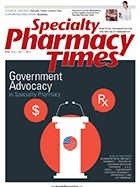Publication
Article
Specialty Pharmacy Times
2016 Specialty Trend in Senior Care
Author(s):
Long-term care pharmacies have seen significant growth among select specialty categories.
SPECIALTY DRUG TREND IS NOT ONLY INCREASING IN THE COMMUNITY SETTING, but also among pharmacies that service patients (i.e. residents) who live in senior care settings such as long term care (LTC) facilities.
The 2016 Managed Health Care Associates (MHA) Independent Long Term Care Member Study1 included a section on specialty medications, which consisted of an analysis of LTC pharmacy dispensing data. Although this is MHA’s sixth year looking at specialty within LTC, due to methodology changes (including short cycle dispensing requirements), the results cannot be compared between previous years prior to study period 2015.
This year’s study periods included an analysis of data from January 1 to September 30, 2014 (study period 2015) versus January 1 to September 30, 2015 (study period 2016). The analysis included claims data from 1231 pharmacies encompassing over 184 million claims.
Almost 3.5 million patients from all 50 states were represented in the study. This article will examine some overall trends, as well as take a deeper dive into specific therapeutic categories.
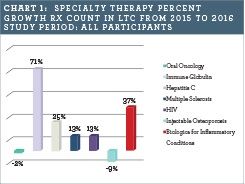
Overall Trends
The results from this study illustrated that LTC pharmacies included in the analysis have seen:
- Significant growth among select specialty categories within LTC pharmacies
- 25% increase in the utilization of medications used to treat hepatitis C, a marked decrease from the 289% growth seen in this category in the 2015 study
- 13% growth in the use of medications to treat multiple sclerosis
- 37% increase in medications used to treat inflammatory conditions (including rheumatoid arthritis, ankylosing spondylitis, Crohn’s disease, ulcerative colitis, psoriasis, and psoriatic arthritis)
- 9% decrease in the use of injectable osteoporosis medications
- 13% increase in the use of medications to treat HIV
- 71% increase in immune globulin therapy
- Relatively stable utilization among oncology products with a 2% decrease in oral oncology products. (See Chart 1: Specialty Therapy Percent Growth Rx Count in LTC from 2015 to 2016 Study Period: All Participants)
Although results from prior years are not comparable, the same methodology was used for the 2015 study (analyzing data from January 1 to September 30, 2013 (study period 2014) vs study period 2015) as the 2016 study. Growth trend for the 2015 study and 2016 study is shown in Chart 2.
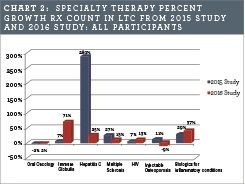
Multiple Sclerosis
Multiple sclerosis (MS) therapies within LTC demonstrated an overall growth of 13% for the 2016 study period. Copaxone (glatiramer acetate subcutaneous injection), the various dosage forms of Rebif (interferon beta-1-a subcutaneous injection), and Gilenya (fingolimod) posted the largest percentage increases.
For the second consecutive year, Rebif remains the most utilized MS drug in the LTC setting by prescription count, overtaking Copaxone in last year’s 2015 MHA Study. Top MS therapies with sustained or increased growth in Rx count in LTC from study period 2015 to 2016 include:
- Copaxone
- Rebif
- Extavia (interferon beta-1b)
- Gilenya
The newer oral disease modifying agents for the treatment of MS, Aubagio (teriflunomide), approved in September 2012, and Tecfidera (dimethyl fumarate), approved in March 2013, continue to have minimal utilization in the LTC setting.
This may be a result of these agents being available via limited distribution through preferred specialty pharmacies, which may be a barrier in accessing these agents through an LTC facility setting.
Recently approved agents Plegridy (peginterferon beta-1a), which was approved by the FDA in August 2014, and Lemtrada (alemtuzumab), which was approved in the United States in November 2014, had minimal utilization in the LTC patient population.
Glatopa (glatiramer acetate), the first generic disease modifying agent for MS, was approved in April 2015 and will be included in the 2017 study. This year marks the first year neurologists have been the primary prescribers of MS treatments for patients residing in LTC facilities. The last 3 years have seen a significant growth in neurologists prescribing MS medications in the LTC space.
Neurologist prescribing constituted 8.7% of MS medications prescribed in the LTC in study period 2014, compared with 25% of prescribing MS medications in LTC in study period 2015, and 32% in study period 2016. Internal medicine and general practice prescribers also have a significant prescribing presence in this space (see Chart 3).
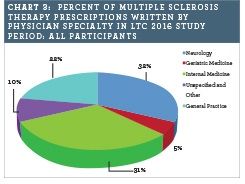
Inflammatory Conditions
Biologics for inflammatory conditions also saw significant growth of 37% in the 2016 study. These products are used to treat diseases, such as rheumatoid arthritis (RA), ankylosing spondylitis, Crohn’s disease, ulcerative colitis, psoriasis, and psoriatic arthritis.
Year over year growth in prescription count was noted for each of the following:
- Stelara (ustekinumab)
- Actemra (tocilizumab)
- Cimzia (certolizumab pegol)
- Enbrel (etanercept)
- Humira (adalimumab)
- Otezla (apremilast)
- Otrexup (methotrexate)
- Xeljanz (tofacitinib)
Xeljanz and Otezla, oral options for RA, psoriatic arthritis, and plaque psoriasis, grew the most in study period 2016. Humira continues to be the most widely utilized biologic for inflammatory conditions in the LTC patient population. Cosentyx (secukinumab) was approved in January 2015 and will be included in the 2017 study. Internal medicine, general practice, and rheumatology prescribers continue to be the lead specialties writing for biologics in LTC facilities (see Chart 4).

Hepatitis C
Utilization of medications to treat hepatitis C virus (HCV) rose 25% in the LTC population from the 2015 to 2016 study period, but that impressive growth trend paled in comparison with the 289% growth seen in this therapeutic class from study period 2014 to study period 2015.
As anticipated, we do see that the trend and utilization in this therapeutic category continue to increase for the newer agents and decrease for older therapies, as treatment guidelines and clinical practice continue to evolve.
Harvoni (ledipasvir and sofosbuvir) was approved in October 2014 for HCV genotypes 1, 4, 5, and 6; Viekira Pak (ombitasvir, paritaprevir, and ritonavir with dasabuvir) was approved in December 2014 for HCV genotype 1; Technivie (ombitasvir, paritaprevir, and ritonavir) was approved in July 2015 for HCV genotype 4; and Daklinza (daclatasvir) was approved in July 2015 in combination with sofosbuvir to treat HCV genotype 3 HCV.
Additional approvals in this therapeutic category are anticipated in 2016 (see Chart 5). Gastroenterologists lead the prescribing of HCV medications, accounting for 43% of the prescribed prescriptions for LTC residents, up slightly from 40% in last year’s study period.
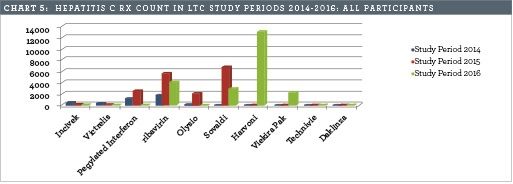
Oncology
The trend in oncology in the 2016 study marked the second straight year of a 2% decrease in oral oncology products in the LTC space. Although overall growth dipped slightly in oral oncology, there was significant growth in many branded oral oncology agents from study period 2015 to 2016.
Among the branded agents experiencing growth in the LTC space:
- Erivedge (vismodegib)
- Imbruvica (ibrutinib)
- Nexavar (sorafenib)
- Revlimid (lenalidomide)
- Taflinlar (dabrafenib)
- Tasigna (nilotinib)
- Xtandi (enzalutamide)
- Zolinza (vorinostat)
Ongoing flat-to-decreased prescribing in the oral oncology therapeutic category within LTC may be due to many of the newer oral oncology agents being launched as limited distribution products through preferred specialty pharmacies, which may be blocking access to these agents in the LTC facility setting. Prescribing for oral oncology products was driven by internal medicine, representing 40% of prescribers.
General practice accounted for 32% of oral oncology prescribing, as oncologists accounted for 5% of the prescriptions in the oral oncology therapeutic category to LTC residents.
HIV
Prescriptions for HIV therapies in the LTC setting grew by 13% from the 2015 to 2016 study period. This may continue to reflect the fact that a growing number of people aged 55 and older are living with HIV. The CDC estimates that persons aged 55 and older accounted for almost one quarter (24%) of the people living with HIV infection in the United States in 2012.3
This represents a jump from 19% in 2010 and is expected to further increase. In addition, older Americans are more likely than younger people to be diagnosed with HIV later in the course of their disease, meaning a delayed start to treatment and potentially more damage to their immune system. This represents a potential opportunity for LTC facilities specializing in HIV/AIDS treatment.
Immune Globulin
The 2016 study marked the first time we saw a dramatic increase in the use of immune globulin therapy for the treatment of LTC residents. Intravenous immune globulin (IVIG) and subcutaneous immune globulin (SCIG) are both used on and off label for a variety of disorders that encompass diseases in neurology, hematology, immunology, nephrology, rheumatology, and dermatology.
It is important to note that although immune globulin has been studied in Alzheimer’s disease, it has not yet been approved for that indication. Prescribing of immune globulin products in the LTC space was driven by neurologists, representing nearly half (49%) of all prescribing in this therapeutic category.
Specialty Trends
While the average number of specialty prescriptions dispensed per LTC pharmacy per month has remained relatively constant throughout the study periods from 2014 to 2016, total specialty pharmaceutical spend has increased significantly over that time period (see Chart 6). Total annual specialty pharmaceutical spend has grown 59% in each of the last 2 studies.
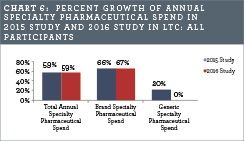
Brand specialty pharmaceutical spend grew 66% in the 2015 study and 67% in the 2016 study. It is anticipated that this huge overall annual specialty pharmaceutical spending increase is largely driven by the significant growth in HCV drug dispensing and spend, primarily from Sovaldi, Harvoni, and Viekira Pak, particularly as generic spend in the specialty space was flat in the 2016 study.
In addition, it was found that the percentage of prescriptions dispensed with a copayment for specialty pharmaceutical products continued to grow from 33% in study period 2014 to 36% in study period 2015 to 37% in study period 2016 (see Chart 7).
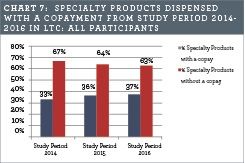
When the patient did experience a copayment, the average copay per specialty prescription was found to be $159 for the 2016 study period. This marks a $10 decrease from the previous study period (see Chart 8).
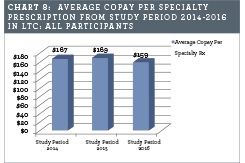
Despite challenges such as specialty limited distribution, preferred or narrow specialty pharmacy payer networks, and compliance with Risk Evaluation and Mitigation Strategies program requirements, these data confirms that LTC pharmacies continue to increasingly provide specialty pharmaceuticals to patients across all LTC settings.
Providing quality, accessible specialty pharmacy services to facilities that care for these patients remains of utmost importance as the population in the United States ages. SPT
References
- MHA Independent Long Term Care Member Study, 2016. Managed Healthcare Associates, Inc, 2016. Available upon request at MHALongTermCare@mhainc.com
- MHA Independent Long Term Care Member Study, 2015. Managed Healthcare Associates, Inc, 2015. Available upon request at MHALongTermCare@mhainc.com
- HIV Among People Aged 50 or Older. CDC, May 2015. Available at http://www.cdc.gov/hiv/risk/age/olderamericans/ Accessed March 10, 2016.
About the AuthorsKIMBERLY BINASO, PHARM D, CCP, FASCP, CGP, FASHP is currently the Vice President of Clinical Services for Managed Healthcare Associates, a healthcare services organization located in Florham Park, New Jersey. Dr. Binaso is a certified consultant pharmacist in the state of New Jersey (CCP), fellow of both the American Society of Consultant Pharmacists (FASCP) and the American Society of Health Systems Pharmacists (FASHP), and a board certified geriatric pharmacist (CGP). For the past 15 years, she has held several clinical management and leadership positions working extensively with both consultant and clinical pharmacist teams in senior care. She is an active member of The American Society of Consultant Pharmacists, The American Society of Health Systems Pharmacists, and the American Medical Directors Association. Dr. Binaso serves as a national visiting professor and senior care expert presenter contributing posters and articles on a variety of geriatric clinical issues.
STACEY NESS, PHARM D, RPH, CSP, MSCS, AAHIVP, has worked in both national specialty pharmacy and payer organizations and has experience in clinical management, adherence, and persistency programs, as well as chronic disease cost optimization strategies. Dr. Ness is active in the Consortium of Multiple Sclerosis Centers, Academy of Managed Care Pharmacy, National Home Infusion Association, National Association of Specialty Pharmacy, Specialty Pharmacy Certification Board, and Hematology and Oncology Pharmacy Association, and has served on the Minnesota Medicaid Drug Formulary Committee since 2008. She is a certified multiple sclerosis specialist, a credentialed HIV pharmacist, a Certified Specialty Pharmacist, and currently serves as the director of specialty clinical services at Managed Health Care Associates, Inc, a health care services organization based in Florham Park, New Jersey.
